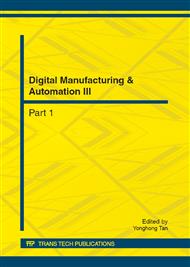p.1290
p.1295
p.1302
p.1306
p.1311
p.1317
p.1321
p.1325
p.1331
Mechanical Drift of Ultrasonic-Linear-Motor-Driving Motion Platforms
Abstract:
During the experiment of cell poking, it is required that the point of a probe is aimed at the cell with the help of a precision motion platform, and then, controlled by this motion platform, the tip of the probe pokes into the cell. When these operations are done, the driving force of this platform will be removed. But within a certain period (for example, an hour), the platform doesn’t stop moving. This kind of movement, which should be only several microns, is termed in this paper as the mechanical drift of ultrasonic linear motors. Experiments show that the forms used for clamping the stator is one of the factors that affect the mechanical drift. It is studied through experiments the impacts of several clamping forms on mechanical drift, the drift value’s relationship with the slide rail’s damping and the motor’s step size, and how the drift direction is related to the motion direction. The mechanism of mechanical drift of ultrasonic linear motors has also been explored preliminarily. This kind of research will facilitate refinements of the design and control methods for ultrasonic linear motor as well as motion platforms.
Info:
Periodical:
Pages:
1311-1316
Citation:
Online since:
July 2012
Authors:
Price:
Сopyright:
© 2012 Trans Tech Publications Ltd. All Rights Reserved
Share:
Citation:


